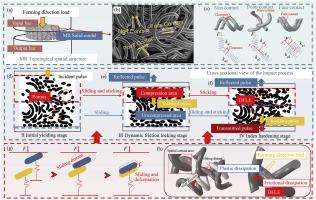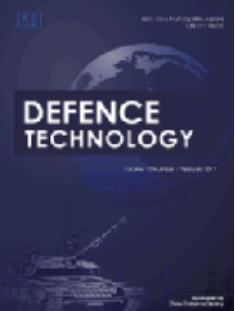Multi-scale impact resistance of flexible microporous metal rubber: Dynamic energy dissipation mechanism based on dynamic friction locking effect
IF 5.9
Q1 ENGINEERING, MULTIDISCIPLINARY
引用次数: 0
Abstract
Flexible microporous metal rubber (FMP-MR) is widely used in national defense applications, yet its mechanical behavior under high-speed impact conditions remains insufficiently explored. In this study, dynamic and static experiments were conducted to systematically investigate the mechanical response of metal-wrapped microporous materials under impact loading that spanned 106 orders of magnitude. By combining a high-precision numerical model with a spatial contact point search algorithm, the spatio–temporal contact characteristics of the complex network structure in FMP-MR were systematically analyzed. Furthermore, the mapping mechanism from turn topology and mesoscopic friction behavior to macroscopic mechanical properties was comprehensively explored. The results showed that compared with quasi-static loading, FMP-MR under high-speed impact exhibited higher energy absorption efficiency due to high-strain-rate inertia effect. Therefore, the peak stress increased by 141%, and the maximum energy dissipation increased by 300%. Consequently, the theory of dynamic friction locking effect was innovatively proposed. The theory explains that the close synergistic effect of sliding friction and plastic dissipation promoted by the stable interturn-locked embedded structure is the essential reason for the excellent dynamic mechanical properties of FMP-MR under dynamic loading conditions. Briefly, based on the in-depth investigation of the mechanical response and energy dissipation mechanism of FMP-MR under impact loads, this study provides a solid theoretical basis for further expanding the application range of FMP-MR and optimizing its performance.

柔性微孔金属橡胶的多尺度抗冲击性能:基于动态摩擦锁紧效应的动态能量耗散机理
柔性微孔金属橡胶(FMP-MR)广泛应用于国防领域,但其在高速冲击条件下的力学性能研究尚不充分。本研究通过动态和静态实验,系统研究了金属包覆微孔材料在106个数量级的冲击载荷下的力学响应。采用高精度数值模型和空间接触点搜索算法相结合的方法,系统分析了FMP-MR复杂网络结构的时空接触特征。在此基础上,全面探讨了从匝拓扑和细观摩擦行为到宏观力学性能的映射机理。结果表明:与准静态载荷相比,FMP-MR在高速冲击下由于高应变率惯性效应,具有更高的能量吸收效率;因此,峰值应力增加了141%,最大能量耗散增加了300%。创新性地提出了动态摩擦锁紧效应理论。理论解释了稳定的互锁嵌固结构促进滑动摩擦和塑性耗散的密切协同效应是FMP-MR在动载条件下具有优异动态力学性能的根本原因。简而言之,本研究在深入研究FMP-MR在冲击载荷作用下的力学响应和耗能机理的基础上,为进一步扩大FMP-MR的应用范围和优化其性能提供了坚实的理论基础。
本文章由计算机程序翻译,如有差异,请以英文原文为准。
求助全文
约1分钟内获得全文
求助全文
来源期刊

Defence Technology(防务技术)
Mechanical Engineering, Control and Systems Engineering, Industrial and Manufacturing Engineering
CiteScore
8.70
自引率
0.00%
发文量
728
审稿时长
25 days
期刊介绍:
Defence Technology, a peer reviewed journal, is published monthly and aims to become the best international academic exchange platform for the research related to defence technology. It publishes original research papers having direct bearing on defence, with a balanced coverage on analytical, experimental, numerical simulation and applied investigations. It covers various disciplines of science, technology and engineering.
 求助内容:
求助内容: 应助结果提醒方式:
应助结果提醒方式:


